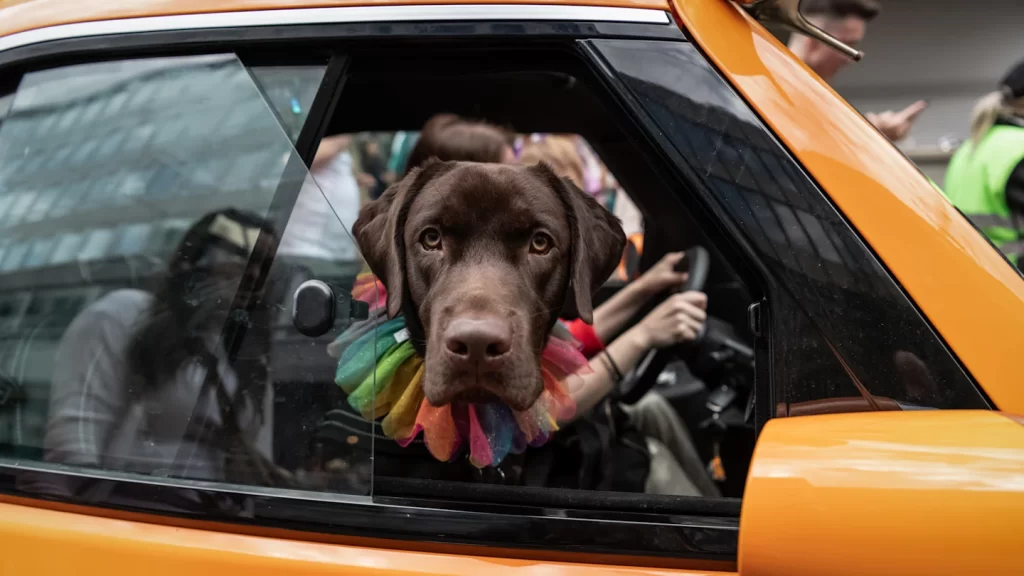Dogs often whine in the car because they feel anxious, excited, or uncomfortable. To stop the whining, you need to gradually desensitize your dog to car rides, make the car a calm space, and train positive behavior consistently using rewards.
Why Does My Dog Whine in the Car?

Dogs whine in the car due to anxiety, motion sickness, or excitement. Some cry to get your attention. Identifying the root cause is key to stopping it.
Common causes of dog whining in the car:
- Anxiety or fear
Triggered by motion sickness, loud noises, or past trauma - Overexcitement
Often linked to fun destinations like dog parks - Discomfort
Confined space, heat, or unfamiliar smells - Attention-seeking behavior
Especially if you usually comfort them when they whine
Signs your dog is stressed during travel:
- Panting heavily
- Drooling or licking excessively
- Pacing or shifting restlessly
- Barking or yelping
- Trying to jump onto your lap or escape the seat
What triggers a dog to cry during car rides?
Most dogs cry when they associate the car with something unpleasant — like vet visits or nausea. Even road noise or bumpy motion can increase stress.
Is it excitement or anxiety causing the whining?
It can be either. Watch their body language. A wagging tail and alert posture indicate excitement, while trembling, cowering, or whining with tucked tails signal fear.
5 Proven Tricks to Stop Your Dog from Whining in the Car
Gradually Desensitize Your Dog to Car Rides

Start small. Get your dog used to sitting calmly in a parked car before ever starting the engine.
Steps to follow:
- Let your dog explore the car with the engine off
- Reward calm behavior with treats or praise
- Turn on the engine while staying parked
- Progress to short 2–5 minute drives
- Gradually increase the trip length
Goal: Build positive associations with the car. If they’re scared, forcing them on long trips reinforces fear.
Make the Car a Comfortable, Familiar Space

Transform your vehicle into a space where your dog feels safe.
What helps:
- Use a crate or pet seatbelt to provide structure
- Line the crate or seat with their favorite blanket
- Add a toy with familiar scent
- Keep windows cracked for airflow
- Play soft music or white noise to ease nerves
Note: Dogs like routine. Familiar smells and comfort objects reduce stress.
Use Calming Aids to Lower Anxiety

Some dogs need extra support beyond training.
Vet-approved calming tools include:
Dog pheromone sprays (DAP)
Natural calming chews (CBD, L-theanine)
ThunderShirts or pressure wraps
Calming collars with lavender or chamomile
Herbal scent diffusers (ensure they’re dog-safe)
Caution: Always consult a vet before trying supplements, especially with other medications involved. And if you’re using metal collars or accessories, you might wonder — is brass bad on dog fur? Always check for potential skin reactions or discoloration, especially with sensitive-coated breeds.
Exercise Before Travel to Burn Energy

A tired dog is a calm dog.
Pre-ride routine:
- 15–30 minutes of playtime or a brisk walk
- Allow a potty break
- Offer a small drink (not too much water)
- Avoid heavy meals 1–2 hours before the ride
Why it works: Burning off energy reduces hyperactivity or whining caused by excess stimulation.
Train Calm Behavior and Reward It

Don’t just manage the whining. Correct it through consistent training.
Teach them:
- Commands like “quiet,” “settle,” or “place”
- Wait calmly before entering the car
- No treats or praise until whining stops
Training Tips:
- Use a clicker to mark silence
- Reward only after your dog is calm
- Avoid yelling — it reinforces attention-seeking behavior
Advanced Tips for Persistent Car Whining
When to Consult a Vet or Behaviorist

Sometimes, whining is more than just bad behavior. If your dog’s stress worsens despite trying everything, you may need professional help.
Consider a vet if:
- Your dog vomits or drools excessively
- Whining becomes worse over time
- You suspect motion sickness
What a vet may recommend:
- Anti-nausea meds like Cerenia
- Mild sedatives for high-stress trips
- Behavioral therapy with a certified trainer
Long-Term Training Plans

Stopping car whining permanently takes consistency.
Training roadmap:
- Use clicker training for clear communication
- Associate car rides with happy destinations (dog park, beach)
- Mix up the destinations so car rides aren’t predictable
- Journal your dog’s progress week by week
Pro tip: Make the car ride the reward itself, not just the destination.
Best Tools to Help Calm Dogs During Travel

What products actually work?
As part of our course insights at Careers Collectiv, our canine behavior experts recommend these travel essentials:
- Crash-tested travel crates for security
- Adjustable dog car seat belts for freedom + safety
- Plush calming beds that reduce motion impact
- Calming chews with chamomile or CBD
- Pheromone collars or sprays for scent therapy
- Sunshades to reduce heat and visual stress
Always make sure your tools are appropriately sized and certified for travel safety.
Common Questions About Dogs Whining in the Car
How do I calm my dog in the car naturally?
Natural methods include desensitization training, calming music, dog-safe lavender sprays, and making the car a familiar, safe space.
Should I ignore my dog whining in the car?
Ignore it if it’s attention-seeking. Rewarding them (even by talking) reinforces the behavior. Only give praise or treats when they’re calm.
Can I sedate my dog for car rides?
Sedation is a last resort. If necessary, your vet can prescribe safe, mild medications based on your dog’s health history.
Will my dog ever enjoy car trips?
Yes — with patience and consistency. Many dogs learn to love rides once they’re confident and associate them with positive experiences.